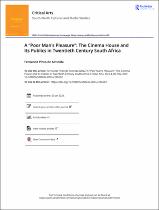| dc.contributor.author | de Almeida, Fernanda Pinto | |
| dc.date.accessioned | 2023-03-29T13:28:52Z | |
| dc.date.available | 2023-03-29T13:28:52Z | |
| dc.date.issued | 2023 | |
| dc.identifier.citation | de Almeida, F. P. (2023). A “poor man’s pleasure”: The cinema house and its publics in twentieth century South Africa. Critical Arts: South-North Cultural and Media Studies, 36(3–4), 89-102. https://doi.org/10.1080/02560046.2023.2166967 | en_US |
| dc.identifier.issn | 1992-6049 | |
| dc.identifier.uri | https://doi.org/10.1080/02560046.2023.2166967 | |
| dc.identifier.uri | http://hdl.handle.net/10566/8706 | |
| dc.description.abstract | What do cinema houses have to tell us about the experience ofcollective leisure in early twentieth-century South Africa? Thisarticle considers how the cinema house points to unprecedentedsocial conditions that allowed the emergence of new publics.Drawing on scholarship on the development of cinema in SouthAfrica, the article considers how the historical transformationsthrough which the cinema has passed since the 1910s suggestattempts to domesticate the space of projection of the cinema aswell as the formation of new cinema audiences. Diverging fromreadings of the cinema in South Africa that focus onfilm, thearticle considers how the cinema house is inscribed in thisscholarship as an evocative cipher of incipient publics and as ametaphor for the containment of a new public sphere during theperiods of segregation and Apartheid. | en_US |
| dc.language.iso | en | en_US |
| dc.publisher | Taylor and Francis Group | en_US |
| dc.subject | Segregation | en_US |
| dc.subject | Apartheid | en_US |
| dc.subject | Politics | en_US |
| dc.subject | South Africa | en_US |
| dc.subject | Culture | en_US |
| dc.title | A “poor man’s pleasure”: The cinema house and its publics in twentieth century South Africa | en_US |
| dc.type | Article | en_US |

